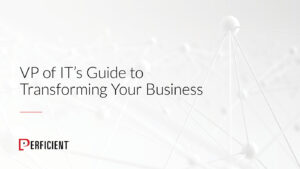In today’s dynamic and competitive business landscape, IT Leaders are constantly seeking ways to optimize their operations and stay ahead of the competition. One crucial decision organizations must make is choosing between a project-driven or a product-driven approach for product development. A project-driven approach prioritizes the completion of individual projects, while a product-driven approach prioritizes the creation and ongoing improvement of one or more specific products.
In our “VP of ITs Guide to Transforming Your Business,” we highlighted the benefits of adopting a product-driven approach over a project-driven one. In this blog post, we will dive deeper into the topic using the chart below to explore the differences between these two approaches and discuss the benefits of being a product-driven organization.

Fund a Project vs. Defining Outcomes
Project-driven organizations usually start a software project with a defined need or goal. In this example, an IT leader might approach a project-driven organization and say, “We want to build a mobile app.” A project-driven organization usually asks follow-up questions like:
- What is this app going to do?
- What is it going to cost?
- What is the business case behind it?
Once established, companies often go to their steering committees for funding.
Alternatively, a product-driven organization approaches the problem differently by defining the outcomes they seek. For example, a product-driven organization might instead focus on defining outcomes, such as:
- Increased customer retention due to high customer turnover
- Increased customer satisfaction due to a high percentage of unsatisfied customers
- Increased overall digital self-service that we cannot currently comply with
- Decreased calls to the calls center because customer support is overwhelmed with calls
- Decreased manual processes like paperwork because it’s inefficient for customers and employees
One possible solution that addresses all these outcomes is a mobile app.
A project-driven approach primarily focuses on securing funding to address a single issue instead of a product-driven approach which first defines specific business objectives to prioritize what’s most important.
Build a Schedule vs. Prioritizing Business Objectives
In a project-driven approach, a schedule primarily focuses on completing tasks within a specified timeframe rather than aligning with the business goals. As there is no guarantee of funding for future phases, organizations may attempt to include as much in the initial project as possible to secure funding. This results in the schedule focusing on task completion rather than prioritizing business goals. This approach can lead to a situation where the business objectives are not given sufficient consideration and are instead added as an afterthought.
In contrast, a product-driven approach focuses on achieving desired business outcomes, not just completing tasks. In this approach, tasks are not just performed for completion but are tied to and prioritized in a way that directly supports achieving the desired business outcomes. The emphasis is on ensuring that the work being done contributes to achieving the desired business objectives and not just completing tasks without a clear connection to the bigger picture.
Assign a Team vs. Fund a Team
For a project-driven approach, organizations typically fund a project and bring together a team of developers, analysts, and Q&A specialists, sometimes from external sources. This approach can result in the team being dispersed to different projects when an urgent need arises. This is commonplace in nearly every industry.
Conversely, product-driven organizations fund a team and are committed to a long-term project, keeping the team intact. By keeping the team together, they can prioritize business objectives, measure results, and ultimately lead to a more successful product release. With a dedicated, funded and focused team on the same project, product-driven organizations can ensure timely completion and adherence to desired standards.
Furthermore, product-driven organizations benefit from their team’s specialized knowledge and expertise. The same team working on the same project can lead to the development of more comprehensive solutions that consider the needs of all stakeholders. In addition, product-driven organizations can better understand user needs and incorporate them into their development cycles, resulting in more efficient and effective releases.
Build and Release vs. Build, Release, Measure, and Iterate
The project-driven approach involves building and releasing the product after a single build. However, this approach can result in an incomplete product that does not meet business outcomes and may have extraneous features that require attention post-launch. It can lead to higher costs, lower customer satisfaction, and a tarnished reputation due to rushed development and testing.
On the other hand, product-driven organizations release their product in multiple builds, enabling them to receive prompt feedback, measure results, and make ongoing improvements. This approach allows them to prioritize business objectives and ensure their product meets user needs, leading to more successful releases. The key to this approach is iteration, which allows for continual refinement and user feedback to prioritize development and achieve desired outcomes.
Estimate CR/Next Project vs. Measure Results
In a project-driven approach, the focus is to deliver capabilities by a specific deadline. The process begins with defining the minimum viable product (MVP) and creating a plan to achieve it. The goal is to release the MVP as quickly as possible and move on to the next project without taking time to evaluate the success of the current project. This pattern repeats with every release.
On the other hand, a product-driven approach involves a significant change in the organization’s approach and operations. The focus is on defining and measuring business outcomes, such as increasing customer conversion rates, reducing conversion costs, and improving the rating of the mobile app. After the product is launched, the company assesses the results and prioritizes the backlog of features and capabilities based on these results, with the aim of achieving better business outcomes. This approach is more focused, requiring a clear understanding of the intended business goals and using results to drive future work. Companies that have already started to adopt a product mindset are less affected by this shift.
Negotiate Next Project Funding vs. Next Release
In a project-driven approach, each project is funded through negotiations, and once completed, the team may dissolve, and the knowledge gained during the project may be lost. The next project is negotiated for funding, and the cycle continues. This can result in losing continuity and needing to reassemble a new team for each project.
In a product-driven approach, funding is allocated to a dedicated team for ongoing innovation and delivery of value for a specific product. The team is funded, and priorities are set based on measuring outcomes and feedback. A product manager may oversee multiple products and make decisions on continued investment to drive better outcomes.
Next Steps
Being a product-driven organization offers numerous advantages over being a project-driven one. It allows for a focus on defining and tracking business outcomes, leads to better business results, and supports continuous improvement through iterative development.
As we move forward, our next blog delves into the critical success factors for transitioning from a project-driven approach to a product-driven one. We examine the steps necessary to make a successful transition and provide insights and best practices to help organizations achieve their goals.
Our “VP of IT’s Guide to Transforming Your Business” is an excellent resource for those seeking an even deeper dive. This guide answers IT leaders’ top questions about cloud strategy, data, DevOps, and product development. It comprehensively examines the latest trends and best practices for driving business outcomes through technology.


Great information. thank you for sharing this information.